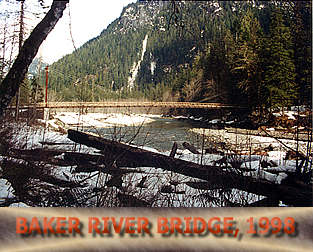 |
USE:
Pedestrian/equestrian
SPAN:
240' w/45' approach ramp
TRAVEL
WIDTH: 6'
TOWERS:
38' tall, 14" x 14" ASTM A847 tube
ANCHORS:
Sahale earth anchors (one side) and twin 1 3/8" rock bolts (one side)
CABLE
STAYS: 1", 1.125", 1.250", & 2" ASTM A 586
Bridge Strand
|
|
The Baker
River Cable Stay Bridge is at the end of the Baker Lake Road, off the
North Cascade Highway in Washington. It is the northernmost trailhead
link of the 14 mile long Baker Lake Trail, an historic prospecting and
lumbering route through old growth forest east of the Mt. Baker volcano.
The bridge crosses the Wild and Scenic upper Baker River; a region subject
to periodic violent flooding that has negated numerous previous attempts
at bridging since 1900. The simple lines and low visual impact of
this bridge perfectly complement the expanse of active river channel,
towering old growth forest, and surrounding snow capped, craggy peaks.
Located
1/2 mile upstream from the trailhead, the Baker River Bridge site is not
accessible to conventional construction equipment. The hydraulic
permit for the project allowed movement of an excavator up the river channel
for the purpose of excavating the footings, and for a small mobile crane
to assist with erection of the towers, but operation of equipment from
within the ordinary high water mark of the river was not permitted. Concrete
for the abutments and anchors was delivered to the site via helicopter,
and for ease of construction the bridge was designed to have maximum component
weight of 4,000 pounds and length under 40'.
To reduce
concrete volume (and expense) earth anchors were used on one side of the
bridge and rock anchors in freight-car-sized boulders were used on the
other. One anchor rock required through-bolting, which was achieved
by tunneling under it for access.
Assembly of the main span was accomplished using two aerial skylines.
Deck, railing, and rigging hardware were moved over the trail to
the bridge site. Photos on this page show skyline carriage with
the bridge under construction, and Bridge Specialist Keith Monohan testing
rock anchors with a 60-ton jack.
|

